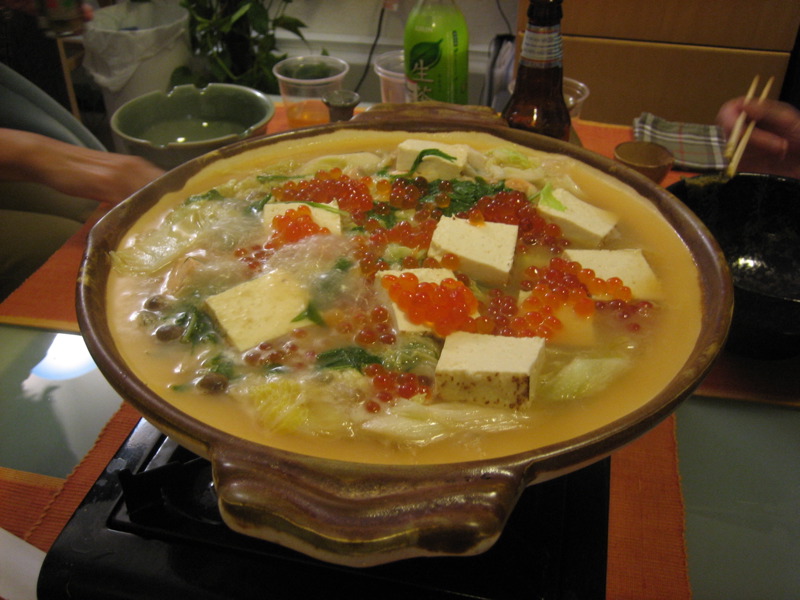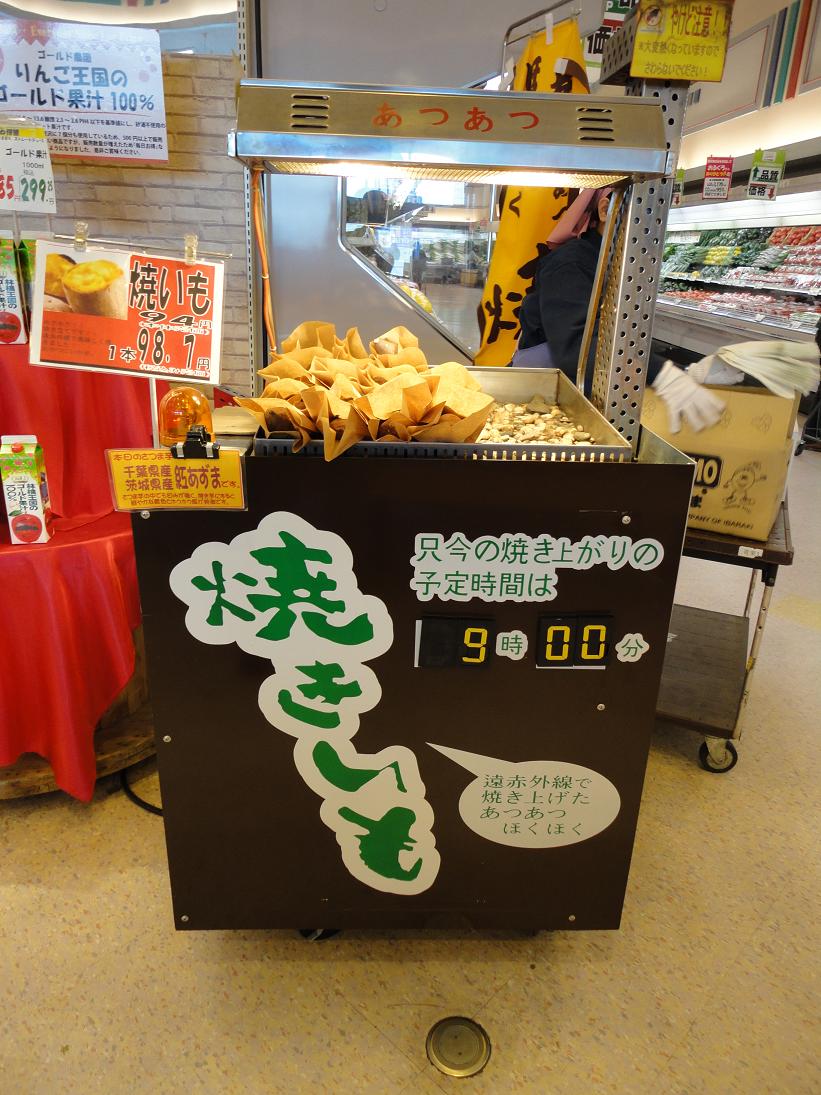Winter in Japan brings with it a whole host of seasonal dishes that often make for the ultimate comfort food. Having lived in the northern island of Hokkaido, I quickly learned that eating the right dishes were essential to surviving the long winter! Here are just a few Japanese dishes that I recommend trying out in the cold season.
Nabe (鍋) – hotpot goodness
鍋 (なべ) itself means ‘cooking pot’, but is more generally used to refer to one pot dishes that are made in the pot, which are usually soups and stews – perfect for winter. These large pots are normally used to cook nabe dishes on top of a portable stove.

Ishikari (Hokkaido) style nabe with ikura/ fish roe. Source: naotakem CC BY 2.0 (https://creativecommons.org/licenses/by/2.0)%5D, via Wikimedia Commons
Cooking nabe is often a very social event where everyone gathers around the table and adds ingredients to the pot, before enjoying their freshly cooked meal. If you have the chance to go to a nabe party, go – it is a great experience!
There are a few well-known types of nabe, including ちゃんこ鍋/ chankonabe (a hearty stew famously eaten by sumo), and 湯豆腐/ yudofu (a simple dish of tofu simmered in a konbu seaweed broth, usually served with ponzu sauce). Nabe also varies by region, such as the Ishikari style nabe featured above.
This post is going on focus on three of the most popular nabe dishes: sukiyaki, shabushabu and oden.
すき焼き Sukiyaki
Sukiyaki consists of thinly sliced beef and other vegetables, cooked in a broth made from a mix of soy sauce, sugar and mirin. Ingredients often used in sukiyaki are tofu, cabbage, mushrooms (shiitake, enoki) and spring onions.

Source: Kapichu [GFDL (http://www.gnu.org/copyleft/fdl.html) or CC-BY-SA-3.0 (http://creativecommons.org/licenses/by-sa/3.0/)%5D, via Wikimedia Commons
Being a winter dish, it often makes an appearance at 忘年会 (ぼうねんかい bounenkai/ end of year parties).
しゃぶしゃぶ Shabushabu
Shabushabu might just be my personal favourite, and it is not just because of the name! Shabushabu gets its name from an onomatopoeic term referring to the process of boiling the meat and vegetables which constitute the dish.
It is important that the meat used is sliced thinly – this allows it to cook in the boiling water in a matter of seconds. You can then dip the meat in a sauce before eating: popular sauces include ponzu and gomadare (sesame sauce).
Chef Mako Okano explains shabushabu in this great video which showcases the types of foods that tend to be used.
A lot of places offer shabushabu 食べ放題 (たべほうだい/tabehoudai – all you can eat) for 60 mins or more for a good price. This makes shabushabu an economic choice in the winter, even for large groups of people.
おでん Oden
Being both filling and warming, oden is the perfect winter food.
Oden is one of the oldest nabe dishes, as it’s origins can be traced back to the 18th century. It is a dish consisting of boiled eggs and vegetables simmered in a soy flavoured dashi broth. There are regional variations, but the most common ingredients are daikon radish, potatoes, chikuwa fishcakes and konnyaku noodles.
The above video takes you through some of the many things you can add to your oden dish!
Oden can be eaten at specialist oden restuarants and traditional yatai stalls, but nowadays can also be found at convenience stores, supermarkets and even vending machines.

You can buy oden from a range of places, but it is hard to beat the traditional yatai food stall experience! Source: Keiichi Yasu [CC BY-SA 2.0 (https://creativecommons.org/licenses/by-sa/2.0)%5D, via Wikimedia Commons
Winter snacks to keep you warm
If you aren’t quite hungry enough for a whole meal, you often pick up other warm Japanese snacks at street stalls or convenience stores:
肉まん Nikuman
Nikuman are steamed pork buns – basically the Japanese version of Chinese baozi. The buns are made from a flour-based dough, and the filling is usually made with pork, spring onions and shiitake mushrooms. You can buy these cheaply from convenience stores, where they are kept nice and hot!

These nikuman are a bit more expensive than what you would find at the convenience store! Source: Japanexperterna (CCBYSA) [CC BY-SA 3.0 (https://creativecommons.org/licenses/by-sa/3.0)%5D
焼き芋 Yakiimo
Sometimes the simplest foods are the best ones, and yakiimo is a great example of this. Yakiimo literally means ‘baked potatoes’. Imo are Japanese sweet potatoes, which have purple skin and are sweeter tasting than their Western counterparts.

Source: Kanesue [CC BY 2.0 (https://creativecommons.org/licenses/by/2.0)%5D, via Wikimedia Commons
Not only are Japanese sweet potatoes delicious when baked, but they are also known for having many health benefits – I recommend trying them at least once!
焼き餅 Grilled Mochi
Mochi (rice cakes) are a popular snack all year round but is especially popular in the New Year period. They can be eaten in many forms, but a nice way to eat in winter is to grill it, which is known as yakimochi (meaning ‘grilled/ baked mochi’).
I became a little bit obsessed with yakimochi after I was first introduced to it. All you need to do is grill the mochi until it is toasted and has expanded. The gooey warmth of mochi when it is grilled makes it a lovely snack to warm you up in the winter!
I hope this post inspires you to try one of these dishes if you haven’t already. There are a lot of various Japanese ingredients mentioned in this post – if you want to learn more, I suggest checking out the following websites:
NHK World’s Japanese Food Glossary
What is your favourite winter dish (Japanese or otherwise)? Please tell me in the comments!

